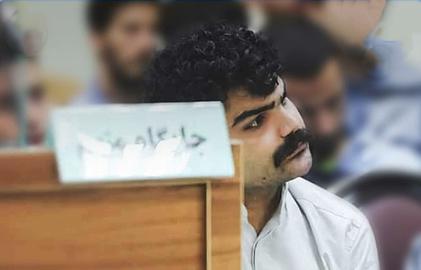“I suggest that you let me sew your lips together because I have already had the experience,” a prisoner tells a cellmate who is preparing for a hunger strike. “I would sew them in such a way that you would not feel pain and you would not bleed.”
There are nine political prisoners in the cell. They all see hunger strikes differently.
One prisoner, who didn't want to give a name, says he would never go on hunger strike. “This type of protest does not attract much attention from the public because it has been done so often, and prison authorities don’t pay the slightest attention either,” he says. “In the end, the prisoner either breaks his hunger strike and yields to the authorities, or it goes on so long that the prisoner dies or suffers from dangerous kidney, liver and heart ailments for the rest of his life.”
Nevertheless, it is common for prisoners to resort to hunger strikes to realize demands. Political prisoners in Iran have gone on hunger strikes since before the revolution. Many consider the tactic an effective way to gain attention outside the prison.
“A prisoner has nothing valuable except his life,” says Mohsen, a political prisoner at Rajaei Shahr Prison west of Tehran. “It is very difficult to put your life on the line and tell the agents of injustice that you would use your life to bring them to their knees.” Prison officials, he says do not care about the suffering of political prisoners.
Punishments for Hunger Strikes
Prison officials consider going on hunger strike an illegal act. “In prison, a hunger strike is a flagrant offence that can be punished,” Mohsen says. “If you confirm that you are on hunger strike, the Prison Organization’s bylaws have punishments in store for you that include 20 days in solitary confinement, suspension of family visits, and disqualification for amnesty. Going on hunger strike requires a lot of sacrifices.”
Sajjad, another prisoner, says that sometimes there is no alternative but to go on a hunger strike. “You remember Hoda Saber and Akbar Mohammadi, don’t you?” he says, referring to two Iranian political prisoners who died while in custody. “A person who goes on hunger strike has already tried other peaceful methods but has made no headway. You cannot imagine the pain of long-lasting uncertainty inside these walls. A prisoner goes on hunger strike when he wants one of his basic rights to be respected, and he has done everything else within his power without getting any results. In other words, he is so desperate that he is ready to commit suicide as a protest against the unbearable situation that he is in.”
Zahra, a woman in prison for “cybercrimes,” says the most valuable hunger strikes are those that are aimed at securing the rights of other prisoners. “We have had hunger strikers who have stood by their beliefs and have refused to give up until they got what they had demanded,” she says. “But others have spoiled this form of protest. Right now, we have a woman inmate whose repeated weekly hunger strikes have become a butt of jokes. We also hear about male prisoners who break their strikes after a couple of days, following false promises from prison officials. Officials want the prisoner’s hunger strike to end, so they use all tricks in the bag. They believe that they are preventing lawlessness in the prison, and they want to discredit the prisoner.”
Shayan, a young man who personally witnessed Hoda Saber’s deadly hunger strike at Evin Prison’s communal Ward 350, admires Saber’s brave struggle. “Saber’s hunger strike was a true protest,” he says. “Within only three days, his physical strength had deteriorated, but he would not give up. We all knew that his situation was critical, but in prison, people on hunger strike are not provided with medical care. That is why that great man came to a tragic end.”
An Expression of Solidarity
Shayan says hunger strikes can be an effective way of showing solidarity with other prisoners in a particular ward. “All the prisoners in the ward unite,” he says. “Even sick inmates refuse the food. In this way, inmates can announce their protest against the violation of a single prisoner’s rights, or a whole ward’s rights. Returning the food means declaring a hunger strike because under normal conditions, all prisoners always accept three meals a day.”
There are different types of hunger strikes. “When a prisoner goes on a “wet” hunger strike, he prepares one bottle of sugary water and one bottle of salted water," Shayan says. “He drinks both bottles each day because, without sugar and salt, the body cannot regulate blood pressure, and he would grow dizzy and faint.” The risks involved in a “dry” hunger strike are more severe. “Without food or water, one and cannot last long. Within 3 to 10 days, the body begins eating itself from inside and result can be a stroke or even death. Most prisoners don’t go on this kind of hunger strike.”
Shayan says the Prison Organization publishes its own statistics on hunger strikes. “They say that 99 percent of hunger strikes get nowhere. What they do not say is that, if the prison upheld the basic rights of the prisoners -- rights that their own laws explicitly provide for -- then there would be no reason for hunger strikes.”
visit the accountability section
In this section of Iran Wire, you can contact the officials and launch your campaign for various problems


























comments